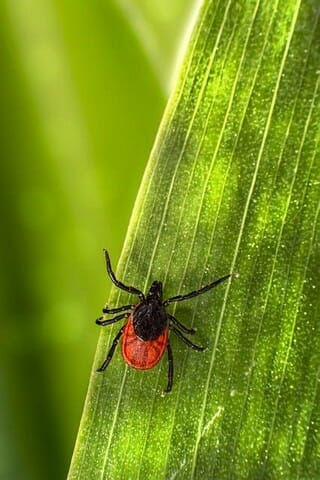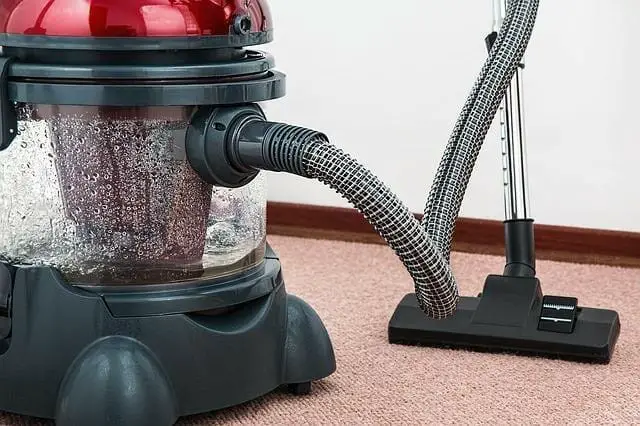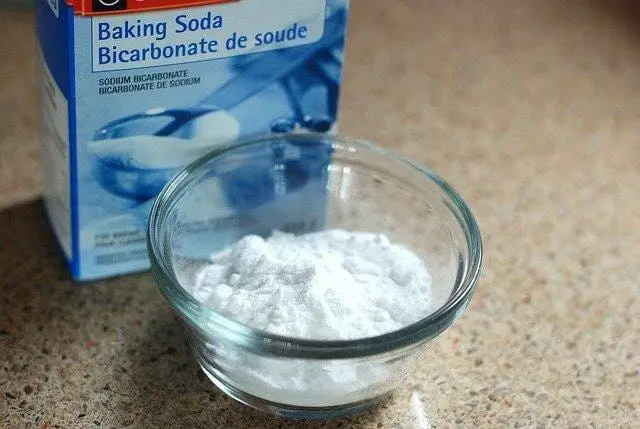Last Updated on June 15, 2023 by Grow with Bovees

Clover mites, also called concrete mites, are small oval-shaped arachnids with 8 legs. Fully grown, a clover mite is a little smaller than a pinhead and has a red to reddish-brown coloring.
Clover mites are usually found in the garden and feed on lawn plants. These tiny pests are difficult to see with the naked eye and when crushed, they can leave a red stain on your concrete pathways, furniture, floor, walls and other surfaces.
- Are Clover Mites Harmful to Humans or Property?
- Clover Mites vs Chiggers
- Why Do I Have a Clover Mite Problem?
- How to Get Rid of Clover Mites?
- Teeny Red Pests — What Is the Most Effective Prevention?
- What Kills Clover Mites?
- Does Baking Soda Kill Clover Mites?
- Does Sevin Kill Clover Mites?
- Using Bifen IT
- What Plants Attract Clover Mites?
- Where Do Clover Mites Lay Eggs?
- Signs of Clover Mite Infestation
- How Can I Prevent Clover Mite Infestations in the Future?
Are Clover Mites Harmful to Humans or Property?
Clover mites are not dangerous to human health. They do not bite like chiggers and other mite species or suck your blood.
They do not cause any damage to your property or destroy clothing, furniture and food. However, if left unchecked, they can invade your home and become a huge nuisance.
If crushed, they leave behind red stains (their pigment not blood) on your furniture, wallpaper, carpets, rugs, walls, floors, etc. Clover mites feed on plants and derive their nutrition from plant juices.
They are not blood feeders, they feed on flowers, clovers, over-fertilized grass, and other plants and, in large numbers, can cause a lot of damage to your garden.
If clover mites invade your home, they will eventually die when they don’t find any plant matter to feed on. However, they may thrive in areas such as patios, rooftops, etc. where there are sources of food available for them, such as algae, mold and mildew.
Clover Mites vs Chiggers
Chiggers tend to inhabit thick brush, whereas clover mites are more commonly found on paved areas surrounding your property. Clover mites will also make their way indoors, as mentioned above.
A clover mite is quite a bit larger than a chigger, an adult will grow to around 1 mm or 3/64 ″ in size, so they are easier to spot than chiggers, which only get to around 0.4 mm when fully grown.
Why Do I Have a Clover Mite Problem?

Your yard probably offers a favorable environment for clover mites to build their nests and thrive. When this occurs, you can see uneven patches of grass on your well maintained lawn, and you may even see them on the fences, the exterior of your home, on the concrete and even inside your home.
Many people ask what these small red insects are on concrete. That is why they are often mistakenly called concrete mites.
Thick shrubbery and vegetation around your home are perfect for clover mites. They do well in cooler weather and their activity peaks as the temperatures drop. Clover mite populations peak in spring and early fall, when the plants in your garden are thriving.
Clover mites flourish in well-fertilized lawns and can enter your home via the cracks and crevices in the windows and doors. Because they are so tiny, they can enter through the tiniest of gaps. They can get into your home through the opening by climbing the home siding and get into the attic and upper levels of your home.
How to Get Rid of Clover Mites?
There are many home remedies and techniques that you can use to get rid of clover mites such as:
Remove Them Manually

Although the clover mites are minute bugs, you can spot them moving around because of their color. You can simply use a vacuum cleaner for clover mite control because if crushed, they will leave a red stain on all the surfaces.
This is a good method to clear clover mites; however, this won’t make clover mites leave permanently.
Sponge the Area
In a cup of water mix a few drops of dishwashing liquid. Using a sponge, wipe across the tables, walls, chairs, concrete and other surfaces.
This will help to kill and remove them. The fragrance of the soap will also act as a repellent to stop clover mites from coming back.
You could also add some essential oils to the mixture for a lasting fragrance that repels naturally. However, while wiping the surfaces with the sponge, take care not to press too hard, or you will end up with streaks of red and a huge mess where their bodies are crushed, which will be very difficult to clean.
Boric Acid
Boric acid kills clover mites and can help to eliminate them. Sprinkle the boric powder on all the common areas in and around your home. The clover mite adults are repelled by the powder, and it acts as a barrier to keep them out.
You can sprinkle the acid powder along the perimeters of the rooms, rugs, carpets, under the appliances, couches, on windowsills, patio doors, door gaps, walls, around the yard fence, outdoor furniture, any concrete crevices around the foundation and around the perimeter of your home.
However, you must reapply the powder frequently because it can get washed away by the rain or blown away by the wind.
Use Vinegar For Clover Mite Control

Mix some white vinegar with water in a spray bottle and spray it directly onto the clover mites or any surface infested with them. You can spray the mixture on your lawn, which can help to kill any that may be hiding in the grass.
However, since vinegar is highly acidic, you should test out the mixture on a small area before spraying it on the entire lawn.
Soap Water
Mix a few drops of dishwashing or liquid laundry detergent in water and fill a trigger sprayer bottle. Spraying the mixture over the clover mites will suffocate and kill them.
Remove them using a wet vac cleaner or a microfiber cloth. Take care not to crush them, or they will leave red streaks behind.
Diatomaceous Earth
Diatomaceous earth (DE) is a natural mite repellent and you can purchase pure, food-grade DE and sprinkle it in strategic locations around your garden and home.
The DE creates a barrier that clover mites will not walk across and this will prevent them from entering your yard. You can also place the DE under the doors to prevent them from entering the rooms in your home.
Baby Powder
The fine powder acts as a very good deterrent. Simply sprinkle the talc on the perimeter and corners of the rooms. You can also line the bed frame and mattress with the powder to prevent them from crawling up the bedposts into your bed.
Teeny Red Pests — What Is the Most Effective Prevention?
Any thick vegetation around your home can be an entry point for clover mites and the best way by which you can prevent clover mite infestation is to remove all the plants and thick growth that may attract them.
Remove an 18-24-inch band of vegetation around your home.
Inspect the structure of your home, including window frames, siding and foundation and check for foundation cracks, sidewalk cracks and crevices which may act as entry points.
They are very good at getting into houses through cracks. Make sure to seal every crack properly as part of your control program to prevent them from entering your home or laying eggs.
What Kills Clover Mites?
Obviously, a bit of pressure applied to the red clover mite will kill it!
A few other options are;
- A few drops of dish soap mixed into some water
- The infamous vinegar and water solution
- Last but not least, good ole’ poison! Any permethrin based insecticide will do the job.
Does Baking Soda Kill Clover Mites?

Baking soda does not kill clover mites; however, it is an excellent way by which you can restrict them to a specific area naturally and prevent them from entering your home.
If you notice a pest problem in your yard or garden, you can use baking soda in a boxed pattern, bordering your yard. This will help to lock the mites in the area, which you can then deal with and also act as preventative measures.
Sprinkling baking soda around window sills, under doors and around the room can also help to keep them under control, allowing you to manage them more easily.
Does Sevin Kill Clover Mites?
Yes, many people have reported a very speedy result using the Sevin lawn insect granules to get rid of clover mites.
Using Bifen IT
If you have a clover mite infestation and have exhausted all the natural and home remedies that we have discussed earlier, then you may have to use chemical controls like Bifen IT to solve the mite problem. You can apply the Bifen IT from the lower foundation exterior walls of your home to the window of the 1st floor.
The area of lawn around the house of 10 to 20 feet (6.1 m) must also be sprayed. For proper results, you must spray thoroughly. Using a sprayer will help to make the job easier and also the application will be consistent. You must spray until the foundation, walls up to the runoff and also the vegetation is completely wet.
You will require around 15 to 20 gallons of finished Bifen IT for every 1,000 sq. ft. area to be covered. Using a vacuum cleaner, pick up all the dead and live mites without crushing them to prevent staining and then the vacuum bag should be disposed of.
What Plants Attract Clover Mites?

Clover mites mainly feed on the vegetation growing on lawns and the most common plants that attract the mites are clovers, flowers, lawn grass, weeds, trees, ornamental plants and shrubs. They love full and over-fertilized grass.
Even if there is no vegetation, they can survive by eating fungi, mildew, mold, compost and other types of organic matter.
While clover mites do not kill their host plants in small numbers, they do not cause a lot of damage; However, if the infestation is very large, then the damage can be significant. You may notice your plant wilting, drooping, yellowing or having stunted growth.
The lawn may have uneven patches, brown or darkened patches and yellowing vegetation where there is a concentration of clover mite populations. Clover mites may not damage turf, but it can be stunted in its growth and even turn gray.
You should also check around any houseplants that you may have. They will congregate in the soil of indoor plants such as palms, so make sure to use some indoor-safe insecticide in these areas.
Where Do Clover Mites Lay Eggs?
The eggs of clover mites are tiny, red colored and spherical shaped. The female mites lay around 70 eggs in places such as under the tree bark, foundation walls, cracks of fence posts and other protected areas with sufficient exposure to the sun, overwintering them during the cool months and protecting them from the freezing temperatures of the winter months, as well as from the summer heat.
The eggs that are laid in early spring are usually dormant during the summer months, and they then hatch during fall.
Signs of Clover Mite Infestation
Clover mites are so tiny that they can be quite difficult to spot. Tiny dots of red pests hanging around indoor plants or mites crawling on the siding and window sills of your home indicate clover mite infestation.
You can also find large populations of clover mites near foundations of buildings or areas like tree trunks, windows, walls, etc. that offer safe places to hide.
Usually, clover mites invade your home during the colder months, seeking shelter and warmth, so it’s a good idea to check the entry points around your home, such as windows, doors, cracks in the wall, vents, etc.
If you have potted plants inside your home, then check for clover mite activity around them. If you’re unable to spot the mites, then look for red stains that may be left on curtains, rugs, furniture, walls, etc.
This is a sign that the mites have been active in the area.
How Can I Prevent Clover Mite Infestations in the Future?

If you have taken steps to eliminate clover mites from your property, then you must ensure that they don’t return. Here are some preventive measures that you can take towards keeping clover mites from returning and re-establishing themselves in your home:
- Keep the perimeter of your home free of grass, remove weeds and other vegetation to keep clover mites away.
- Avoid over-fertilizing your plants, because this provides additional nutrients and attracts clover mites into your garden.
- Avoid over-watering your plants because the stagnant water makes the soil very soft and erodes surfaces that encourage them to build their nest.
- Mow the lawn and trim the areas of thick growth, prune tree branches and shrubs around your home to prevent clover mites.
- Seal all entry points into your home, such as doors and windows. Repair, caulk or replace all the portions which may serve as entry points to these pests.
- Use tightly fitting screens on the windows to keep clover mites and other pests out.
- Use sticky tape to trap them by applying the tape in areas such as doors, windows, walls and other entry points. The clover mites will stick to the sticky tape, get trapped and die.
- Dig a strip of 24 inches (0.61 m) at least around your home that is free of any vegetation or plant matter. Fill this with dry soil, coarse sand, pebbles, lava rock, pea gravel, marbles, wood chips or landscape rocks, which will help to prevent them from entering your garden or home.
If you have a clover mite infestation, don’t panic. They can be controlled; however, it requires effort and patience. If one technique does not work, don’t give up.
You may have to use multiple remedies to get rid of the mites effectively. And, if all the remedies don’t work in controlling and getting rid of the clover mites from your home, then it may be time to call a professional pest control specialist to do the job.
